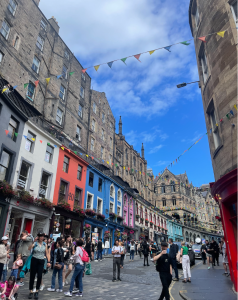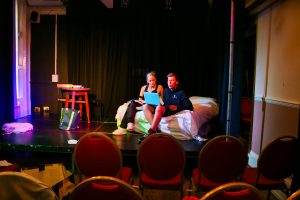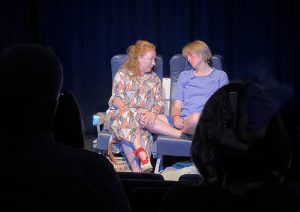
What I Learned from the Fringe
by Nelson Fernandes Serrao | August 29, 2023
It’s the end of August and the crowds are filtering out of Edinburgh. And the conclusive thoughts are filtering in. Here’s what I learned at the Fringe.
In: £15 (minimum) street food, high-concept clown shows, lanyards, tunnocks caramel wafers, raincoats, the looming presence of Phoebe Waller-Bridge.
Out: affordable accommodation.
“A laugh a minute”
I was told a completely untrue tale about a lost Western called ‘The Last Gun’ in Will BF: The Last Gun. A large television on an otherwise empty stage greeted the audience. It took a brave volunteer to venture onstage and insert a VHS tape in the player below. “THANKS :)” says the screen. And then it began. The show was about a lost 80s film by Steven Spielberg’s oldest rival – Orville Movie – a low-budget hero’s journey set in a world with no weapons. The show stitched together a documentary from interviews with the filmmakers (all played by the writer in a variety of wigs, headgear, and accessories). Will BF was onstage for almost all of it, recreating scenes from the movie. Inevitably, he needed more characters, which led to some of the most charming audience participation I’ve ever seen. It worked particularly well during an escape scene where an audience member had to mould props for the scene out of plasticine in real time. “It was a good thing I had my trusty disguise”, BF remarked, looking over at our participant expectantly.
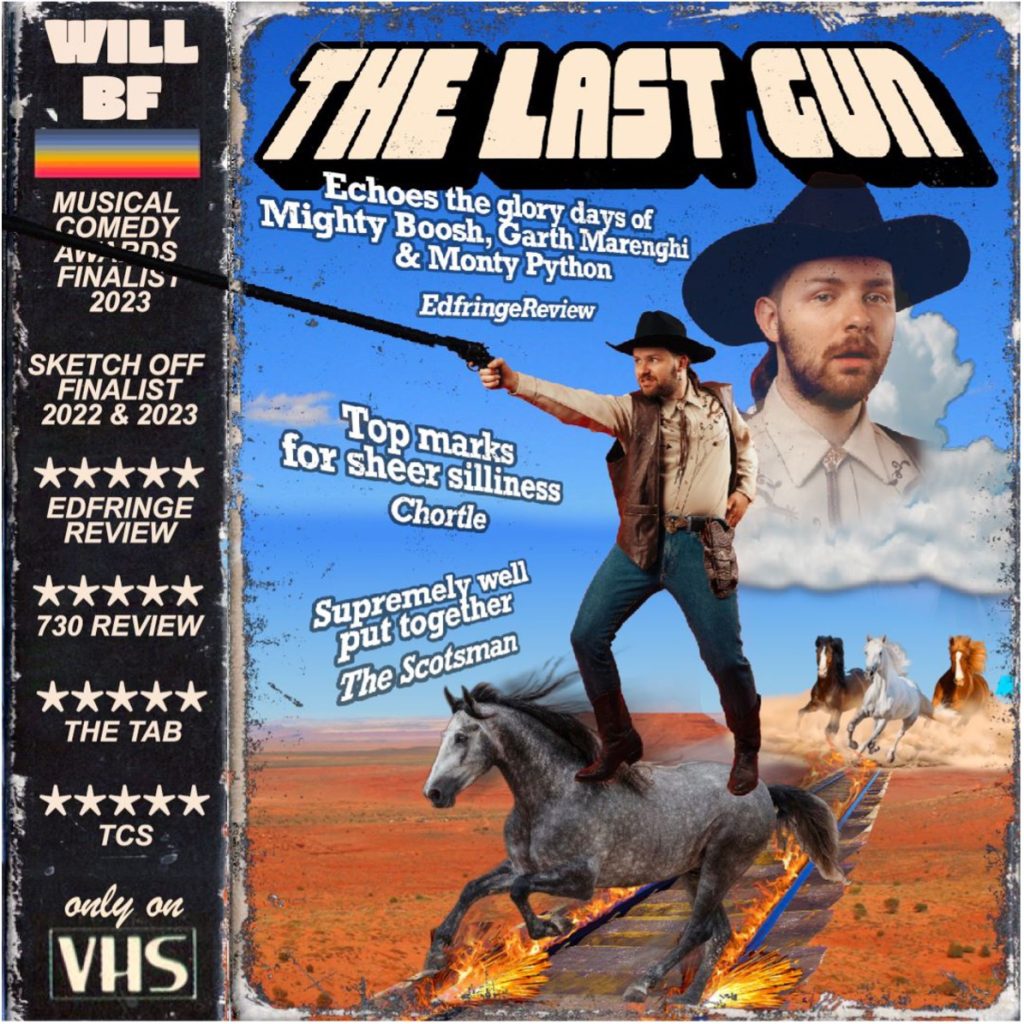
I learned that there is nothing a Fringe audience member wants more than to be involved in the action. Diana: The Untold and Untrue Story was a masterclass in audience involvement, during which cards were dealt out with ‘parts’ to numerous audience members. As the show went on, they went onstage to fulfil their roles, reading lines projected onto the main screen. The Fringe crowd, full of thespians and Americans, were more than ready for this task: everyone asked was thrilled, exuberantly reading their parts. The roles not dealt out to audience members, or to brilliant co-director Joseph Martin, were the Royals, almost all played by cardboard cut-outs. Charles was represented by a faded, grey cutout of his current elderly self, with crude scribbles of black sharpie colouring over his grey hair to give the impression that this is supposed to be a younger man. It was a lesson in being at once critical and lighthearted: the early romance scenes (with Karp playing then-fifteen-year old Diana) were more than grotesque; the tampon-phone-call scandal, which couldn’t go ignored, was turned into a reasonably long ballet-inspired interlude. My only disappointment was not being able to catch Karp’s reprisal of his previous hit show, How to Live a Jellicle Life: Life Lessons from the 2019 Hit Movie Musical Cats.
With this being said, Untrue Diana’s audience participation seemed like child’s play as I came out of Trainspotting Live, a rollicking re-enactment of the film. Harry Gibson’s adaptation left nothing out of the original suppository scene (look it up): each night Andrew Barrett’s Renton would thrust a shit-covered hand into a spectator’s almost-full pint of beer. As the audience groans and squeals, the show slides into almost pure panto. A minute later he bounds back to the victim, takes the cup of muddied, murky beer, and downs it. Trainspotting Live was a mucky, enjoyable spectacle, pushing the exact buttons the denim-coated millennial audience craved, even if they cried out, and swerved away. Perhaps I’m slightly smug, since I found out later I was sitting in what the directors call, “the safe zone”…
I learned about crime. In Mad Ron: Crime School, the audience are in for a criminal masterclass from Uxbridge’s third hardest man. Mad Ron comes onstage scowling, silent, and after a beat, sets his Guinness down and approaches a front-row audience member with a playing card: “Is this your card?” They can say nothing but ‘yes’. The twenty-odd people in the crowd sense there is no other answer. Mad Ron’s show was a lovably entertaining, dad-joke filled hour of false nostalgia and brilliant one-liners. A few latecomers enter awkwardly, unavoidably conspicuous because the show was taking place in a shipping container (Assembly’s ‘box’ space). Once settled, Mad Ron approaches them. “Is this your card?”
Dotted around larger Fringe venues are the Darkfield trilogy: three shipping containers with immersive binaural experiences created by Glen Neath and David Rosenberg, two creators often credited with pioneering immersive theatre in the late nineties. Eulogy, Coma, and Séance are 20-45 minute audio performances conducted in complete darkness. The best way to experience these was to ignore any sceptical instincts and go along with it, to feel yourself drifting off as they tell you to “go to sleep”, allow yourself to be, predictably, jolted awake with a pounding thud. A bit Thorpe Park, but also genuinely impressive, properly immersive sound design.
I learned that ‘clowning’ means physical comedy without words. By far the best one I saw was Grainne Young-Monaghan’s show Barry, which was performed in the SpiegelYurt, a tent right next to the Potterrow Underpass. It’s a cosy, strange, quaint setting, defining itself against the bigger venues like Assembly. Barry made me realise that one crucial part of putting on a good Fringe show is the audience being on the same side as the performer, in this case whilst we were taken on an ‘absurdist picnic voyage’ where everyone was made and given a jam sandwich and a crown at the end.
“Want to see some tits?”
Edinburgh shows are often fuelled by nudity and shock-factor. I heard about multiple shows involving nude performers and raw meat being birthed, cooked, eaten. After a few days of the Fringe, you’re not surprised to see a performer enter the stage in the nude; yet Trash Salad was an unpredictable, genuinely joyous riot, and one I could feel rolling towards cult status as the weeks went on. Creator Rosa Garland mimes the act of fingering her partner (played by a lettuce), then something snaps, and she faces us: “Why didn’t you guys tell me she wasn’t real?” – her sudden naturalism catching us all off guard. She laughs and continues with “the next bit”. Near the end, there is a semi-heartfelt plea to ‘compost mother’, played by an ethereal robotic voice, who offers Trash some ‘grounding exercises’. In Trash Salad the cleanest food became dirty, and it was brilliant.

Photo: Rosa Faye Garland
Of course, these hits were couched amongst a number of misses: I spent regrettable hours in plays I didn’t understand – we went as far as to coin the term “man play” so as to mean, a piece of (figuratively) masturbatory theatre: the man play, whether taking itself seriously as a play or leaning into farcical comedy, has a unique flavour of smugness and unshakeable self-confidence. It’s hard to word, and of course, transcends gender, but you’ll know if you’ve seen one. I think it is unsurprising in this strange vortex of low quality-control and increasingly high cost of access.
But it’s thrilling to be in a beautiful old city completely overtaken by creativity and new, random culture for a month. Ultimately, I learned that if you can (afford to) overlook the standard twelve pound tickets plus booking fee, you may well find something joyous in it all.∎
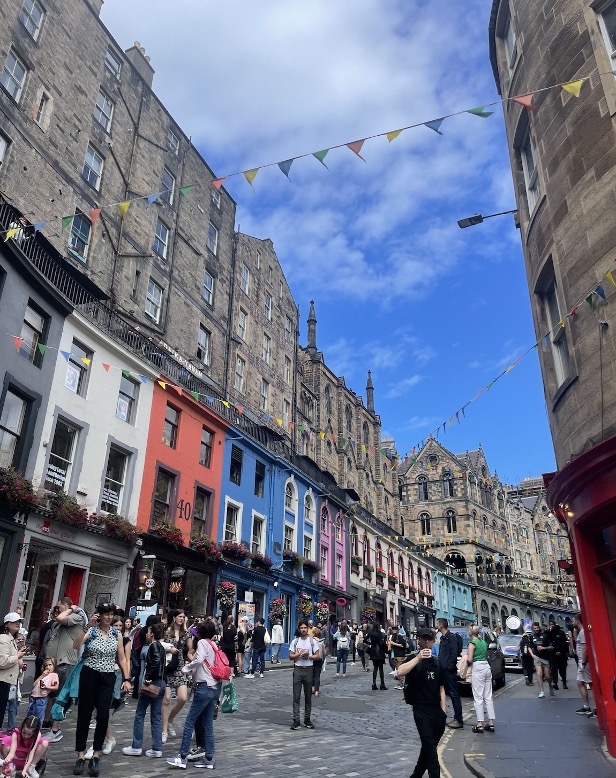
Words and featured image by Julia Males
